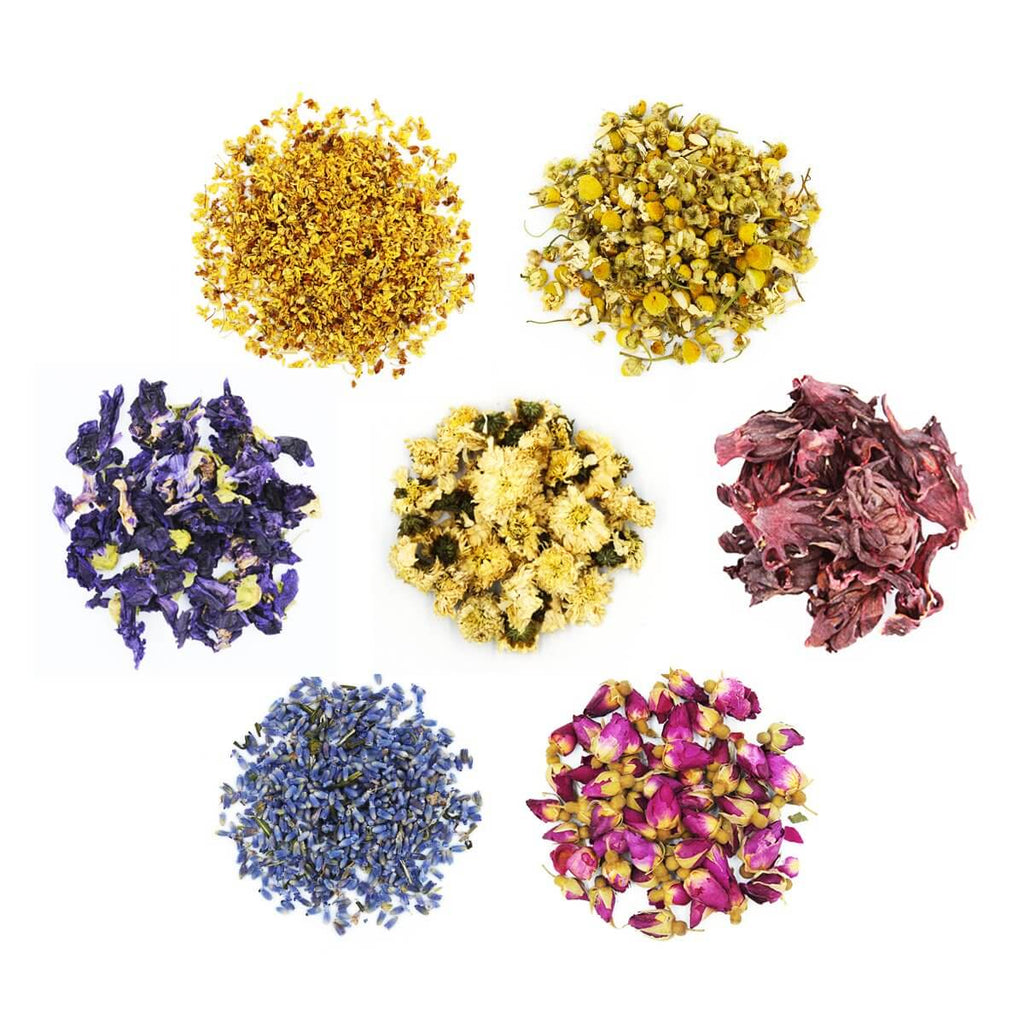Discovering Unique Floral Infusions with Creative Flower Tea Recipes
Posted by JESSIE X

There’s nothing quite as soothing and refreshing as a warm cup of tea. But have you ever considered flower tea? Yes, you read that right – tea made from actual flowers!
This innovative twist on traditional tea brings about not only delightful flavors but also a feast for the eyes.
In this article, we will delve into the enchanting world of flower tea, exploring its myriad flavors, benefits, and how you can create your own floral tea recipes.
Why Choose Flower Tea?
Flower tea isn't just about flavor; it's an experience. The vibrant hues, delicate aromas, and potential health benefits make flower teas a unique choice. From calming anxiety to aiding sleep and even assisting in weight loss, different flowers offer different advantages.
Let's begin by unraveling some captivating flower tea flavors and their benefits:
- Passion Flower Tea for Anxiety and Sleep: Known for its calming properties, passion flower tea is a wonderful option for reducing anxiety and promoting restful sleep. It's a natural way to unwind after a long day.
- Pea Flower Tea: Vibrantly blue, pea flower tea is rich in antioxidants and is believed to support heart health. Its unique color adds a touch of magic to your cup.
- Hibiscus Flower Tea: This tart and ruby-red tea is not only visually appealing but also beneficial for maintaining healthy blood pressure and boosting your immune system.
- Yarrow Flower Tea: Yarrow flowers steeped in hot water create a tea that's said to aid digestion and promote skin health. Its earthy flavor is both grounding and refreshing.
- Lotus Flower Tea: Delicate and elegant, lotus flower tea is known for its potential to soothe nerves and improve mood. It's an embodiment of tranquility in a cup.
Making Tea With Fresh Flowers and Dried Flowers
Making tea with flowers is a wonderful way to enjoy their natural flavors and benefits. Whether you choose fresh or dried flowers, the process is quite simple and can offer a delightful and soothing experience.
Fresh Flower Tea:
When using fresh flowers, here’s how you can make a flavorful cup of tea:
Step 1: Select Your Flowers
Opt for edible flowers like chamomile, lavender, violets, rose, jasmine, hibiscus, or elderflower. Remember, only use petals and ensure they are chemical-free.
Step 2: Rinse the Flowers
Gently wash the petals with cool water to eliminate any dirt.
Step 3: Boil Water
Bring fresh water to a boil and let it cool for a moment to around 190°F to 200°F (87°C to 93°C).
Step 4: Steep the Flowers
Place the petals in a teapot or infuser, and pour the hot water over them. Allow the flowers to steep for 5-10 minutes, depending on the flower type and your taste preference.
Step 5: Strain and Enjoy
Filter out the flowers using a strainer and pour the tea into a cup. Sweeten with honey, sugar, or lemon if you like. Sip and relish your floral creation.
Note: Different flowers may need varying steeping times, so it’s fun to experiment and find your ideal balance.
Dried Flower Tea:
Working with dried flowers follows a similar process, but there are a few nuances:
Step 1: Choose Your Flowers
Pick dried, edible flowers such as chamomile, lavender, rose, hibiscus, or elderflower. Stick to petals and ensure they’re pesticide-free.
Step 2: Boil Water
Bring fresh water to a boil and let it cool for a moment to around 190°F to 200°F (87°C to 93°C).
Step 3: Measure the Flowers
For each cup, use about 1-2 teaspoons of dried flowers, adjusting according to how strong you want the flavor.
Step 4: Steep the Flowers
Place the dried flowers in an infuser or teapot and pour the hot water over them. Let the flowers steep for 5-10 minutes, adapting to the flower type and your taste.
Step 5: Strain and Enjoy
Filter the flowers using a strainer and pour the tea into a cup. Sweeten as per your preference. Sip and enjoy the floral goodness.
Note: Dried flowers tend to carry a more concentrated flavor than fresh ones. Store them in an airtight container in a cool, dry space to retain their taste and aroma over time.
Creating Your Own Flower Tea Blends
Now that we've piqued your interest, let's dive into the exciting realm of crafting your own flower tea combinations. The possibilities are as limitless as your imagination. Here's a simple guide to get you started:
1. Hibiscus and Pea Flower Blend:
Combine dried hibiscus petals with vibrant blue pea flowers for a visually stunning and tangy-sweet brew. This blend offers a double dose of antioxidants and a refreshing flavor profile.
2. Passionflower and Chamomile Elixir:
For the ultimate relaxation potion, blend passion flowers with chamomile. This combination can help ease anxiety and gently guide you into a peaceful sleep.
3. Lotus and Lavender Infusion:
Pair the serene essence of lotus flowers with the calming aroma of lavender. This blend is perfect for those moments when you need to unwind and find your inner balance.
Creative Flower Tea Recipes
These flower tea recipes are just the beginning of your journey into the world of creative tea infusions. Don't be afraid to experiment with different flower combinations and additional ingredients. The key is to let your taste buds guide you and to have fun in the process.
1. Butterfly Pea Flower Tea Elixir
Let's begin our floral journey with the mesmerising butterfly pea flower tea. Derived from the striking blue butterfly pea flowers, this tea is not only a feast for the eyes but also a healthy and delicious choice. To create a vibrant cup of butterfly pea flower tea, you'll need a handful of dried butterfly pea flowers and a tea pot.
Boil the Water: Start by boiling fresh water. Once it's heated, pour it over the dried butterfly pea flowers in your teapot. Let them steep for about 5 minutes. Watch as the blue hue from the flowers gracefully dances in the water.
Serving the Elixir: Pour the tea into cups. Now, here comes the fun part. Squeeze a dash of lime juice into each cup. Witness the magical transformation as the blue tea turns into a deep purple with the acidity of the lime. It's not only a treat for your taste buds but also a feast for your eyes.
2. Chrysanthemum Blossom Tea
Moving on, let's explore the delicate flavors of chrysanthemum flower tea. This classic brew is known for its light and floral taste, which is as calming as it is refreshing. Gather a handful of chrysanthemum flowers and your trusty teapot.
Petals to Pot: Place the chrysanthemum flowers into the teapot. Bring water to a boil and carefully pour it over the petals. Allow them to steep for around 3-4 minutes. You'll witness the petals releasing their soothing essence into the water.
Sip and Enjoy: Once the tea is ready, pour it into cups. The pale golden hue of the chrysanthemum tea is as inviting as a sunny morning. You can enjoy this tea as is, or if you prefer a tangy twist, add a splash of lemon juice. The citrusy notes beautifully complement the floral tones of the tea.
3. Dandelion Herbal Bliss
Now, let's step into the world of herbal wonders with dandelion flower tea. Dandelions are often seen as pesky weeds, but their flowers can create a surprisingly flavorful and healthy tea. To start your dandelion adventure, collect some fresh dandelion flowers from your garden.
Floral Harvest: Pluck a handful of fresh dandelion flowers. Rinse them thoroughly to remove any dirt.
Infusion Time: Place the cleaned flowers in your teapot. Bring water to a gentle simmer and pour it over the flowers. Allow them to steep for around 5 minutes. The result is a light and earthy infusion.
A Touch of Sweetness: Dandelion tea can have a slightly bitter undertone. To balance this, consider adding a drizzle of honey. The natural sweetness of honey complements the earthiness of the dandelion, creating a well-rounded flavor.
4. Rose and Citrus Symphony
Our flower tea exploration wouldn't be complete without the elegance of rose petals. Roses are not only a symbol of love but also a delightful addition to your tea collection. For this floral symphony, you'll need a handful of fresh rose petals and your tea essentials.
Petal Power: Place the rose petals in your teapot. Bring water to a boil and pour it over the petals. Let them steep for about 4 minutes. The tea will take on the gentle aroma and color of the roses.
Zesty Twist: To elevate this floral tea, try adding a dash of lime juice. The zesty notes will harmonize with the floral tones, creating a melody of flavors that dance on your palate.
Conclusion
Flower tea is more than a beverage; it's an art form. The amalgamation of colors, scents, and flavors creates a multisensory experience that is as therapeutic as it is delicious. So why not trade your usual tea for a burst of petals and flavors?
With a little creativity and the right blooms, you can concoct your own floral symphony in a teacup. So, go ahead – explore, experiment, and enjoy the captivating world of flower tea. Your taste buds and well-being will thank you.
SHARE:

AUSTRALIA'S FINEST LOOSE LEAF TEAS
Explore Australia's largest selection of Premium Teas & All-Natural Organic Herbal Blends.


